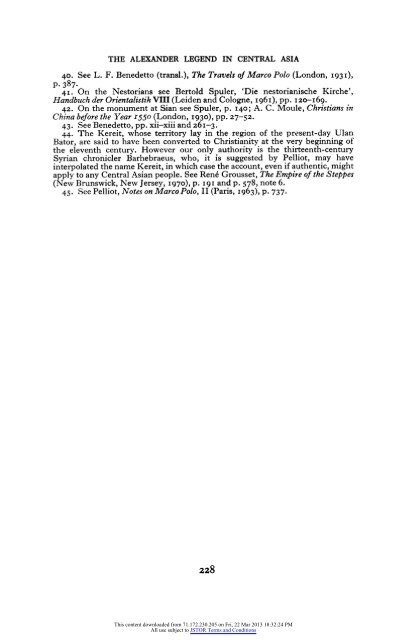THE ALEXANDER LEGEND IN CENTRAL ASIA 22. xviii. 85-9. See Rodwell's translation (Everyman's Library), p. 188. Cf. the verses by Mohammed's court poet, IIass<strong>in</strong> ibn Thdbit, translated by R. A. Nicholson, A Literary History of the Arabs (London, I907), p. i8, and quoted by Anderson, p. 29, note i. 23. See J. A. Boyle, 'Turkish and Mongol Shamanism <strong>in</strong> the Middle Ages', Folklore 83, pp. 177-93 (187-8). 24. <strong>The</strong> most recent and most complete translation is that by a 'Nun of Stanbrook Abbey' <strong>in</strong> Christopher Dawson (ed.), <strong>The</strong> Mongol Mission (London, 1955), PP. 3-84. 25. R. A. Skelton, Thomas E. Marston and George D. Pa<strong>in</strong>ter, <strong>The</strong> V<strong>in</strong>land Map and the Tatar Relation (New Haven and London, 1965), pp. 64 and 66. I have omitted the italics with which Pa<strong>in</strong>ter <strong>in</strong>dicates phrases and passages absent from Carp<strong>in</strong>i's account. 26. See B. B. Szczesniak, 'Notes and Remarks on the Newly Discovered Tartar Relation and the V<strong>in</strong>land Map', Journal of the American Oriental Society 86, pp. 373-6 (p. 376); Denis S<strong>in</strong>or, 'Mongol and Turkic Words <strong>in</strong> the Lat<strong>in</strong> Versions of John of Plano Carp<strong>in</strong>i's Journey to the Mongols (1245-1247)', <strong>in</strong> Mongolian Studies, ed. L. Ligeti (Amsterdam, 1970), pp. 537-51 (544-5). 27. See Anderson, pp. 44-5. <strong>The</strong> work is referred to as Pseudo-Methodius because the St Methodius to whom it is always ascribed <strong>in</strong> the manuscripts was martyred <strong>in</strong> the early 4th century. '<strong>The</strong> <strong>in</strong>fluence of Pseudo-Methodius', Anderson remarks, p. 49, 'was truly immense, and . . . the statement of Sackur may be mentioned, namely that dur<strong>in</strong>g the Middle Ages the <strong>in</strong>fluence of Pseudo-Methodius was second only to that of the Canon and the church fathers. <strong>The</strong> reason for this is not far to seek: as Christendom was threatened by each new peril <strong>in</strong> the later centuries of the middle ages - the Mongol <strong>in</strong>vasions and the westward advance of the Turks even to the walls of Vienna - Christendom <strong>in</strong> its direst need and darkest hour found <strong>in</strong> Pseudo-Methodius not only hope but even assurance of f<strong>in</strong>al victory over Gog and Magog and the might of Antichrist.' 28. See Anderson, p. 46; Ernst Sackur, Sibyll<strong>in</strong>ische Texte und Forschungen (Halle, I898), p. 72. 29. Sackur, pp. 63-4. 30. It is probably much older still, for, as Sackur remarks, p. I6, the Land of the Sun rem<strong>in</strong>ds one of the Babylonian Mounta<strong>in</strong> of the Sunrise at the edge of the world, on to which Shamash, the Sun God, stepped out after pass<strong>in</strong>g through the Eastern Gate at the beg<strong>in</strong>n<strong>in</strong>g of his journey across the sky. See L. W. K<strong>in</strong>g, Babylonian Religion and Mythology (London, 1899), pp. 32-3. 31. Sbornik Letopisei, I/i, transl. A. A. Khetagurov (Moscow-Len<strong>in</strong>grad, 1952), pp. 153-4. 32. See Liu Mau-tsai, Die ch<strong>in</strong>esischen Nachrichten zur Geschichte der Ost- Tiirken (T'u-kiie) (Wiesbaden, 1958), I, 40. 33. x. 2. See Anderson, p. 7. 34. xxxviii. 1-3. 35. See Anderson, p. 7. 36. xx. 7-8. 37- See Anderson, pp. 91-104. 38. For a translation of the Greek version of the story see Adolf Ausfeld, Der griechische <strong>Alexander</strong>roman (Leipzig, 1907), pp. 83-4. <strong>The</strong>re is, curiously enough, no English translation of the Greek text. On the other hand, the 5th-century Armenian version, which follows the orig<strong>in</strong>al very closely, is now accessible to the English-speak<strong>in</strong>g world. See Albert M. Wolohojian (transl.), <strong>The</strong> Romance of <strong>Alexander</strong> the Great by Pseudo-Callisthenes (New York and London, 1969). Unfortunately the present passage (Wolohojian, pp. ii5-16) is corrupt <strong>in</strong> the Armenian text. With the motif of the she-asses Merkelbach, p. 99, compares the story <strong>in</strong> Herodotus (iii. oz2-5) about the use by the Indians of a female camel to escape the pursuit of the giant, gold-digg<strong>in</strong>g ants. 39. See Karl Jahn (transl.), Die Geschichte der Oguzen des Rarid ad-D<strong>in</strong> (Vienna, 1969), p. 26. 227 This content downloaded from 71.172.230.205 on Fri, 22 Mar 2013 18:32:24 PM All use subject to JSTOR Terms and Conditions
THE ALEXANDER LEGEND IN CENTRAL ASIA 40. See L. F. Benedetto (transl.), <strong>The</strong> Travels of Marco Polo (London, 193 I), p. 387. 41. On the Nestorians see Bertold Spuler, 'Die nestorianische Kirche', Handbuch der Orientalistik VIII (Leiden and Cologne, 1961), pp. 120-I69. 42. On the monument at Sian see Spuler, p. 140; A. C. Moule, Christians <strong>in</strong> Ch<strong>in</strong>a before the Year r550 (London, 1930), pp. 27-52. 43. See Benedetto, pp. xii-xiii and 261-3. 44. <strong>The</strong> Kereit, whose territory lay <strong>in</strong> the region of the present-day Ulan Bator, are said to have been converted to Christianity at the very beg<strong>in</strong>n<strong>in</strong>g of the eleventh century. However our only authority is the thirteenth-century Syrian chronicler Barhebraeus, who, it is suggested by Pelliot, may have <strong>in</strong>terpolated the name Kereit, <strong>in</strong> which case the account, even if authentic, might apply to any <strong>Central</strong> <strong>Asia</strong>n people. See Ren6 Grousset, <strong>The</strong> Empire of the Steppes (New Brunswick, New Jersey, 1970), p. 91 and p. 578, note 6. 45. See Pelliot, Notes on Marco Polo, II (Paris, 1963), p. 737. 228 This content downloaded from 71.172.230.205 on Fri, 22 Mar 2013 18:32:24 PM All use subject to JSTOR Terms and Conditions
















